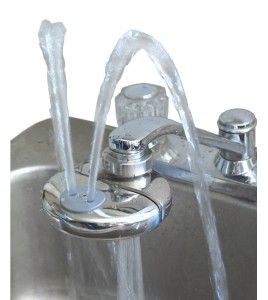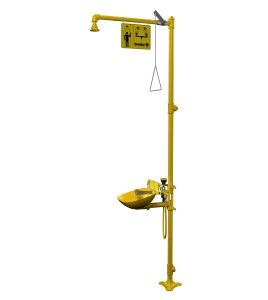Emergency Showers
In this section, you will find product of emergency wash and rinse for your eyes, face and full body. Indeed, the 10 to 15 first seconds following an incidental exposure to hazardous substances are decisive for the health and safety of workers. Emergency showers and eyewash stations should always be part of your safety precautions because they provide on-the-spot decontamination by flushing away the substances to minimize the effects of accident exposure to chemicals. An emergency shower should always be chosen according to a set of factors:
1. In areas at high risks for the eyes: an eyewash station should be installed in the premises and easily accessible in 10 seconds. This apparatus features a nozzle with sprayheads allowing a precise rinsing stream directed in the eyes.
2. In areas at high risks for the eyes and the face: it is recommended to install a facial wash station. This apparatus features a larger nozzle for a stronger stream allowing one to rinse thoroughly both eyes and face.
3. In areas at high risks for the eyes or face and the body: it is recommended to opt for a combination fixture. This type of apparatus features a shower head that rinses the body and eye/face wash station for a complete washdown.
Furthermore, you should consider the environment where the emergency shower will be installed. Beware in particular of any risk of freezing or the presence of corrosive vapors. You may also need to install an alarm to alert rescuers when an emergency shower is activated.
Here are the equipment offered at Sylprotec:
- Wall-mounted or built-in eyewash station
- Pedestal mounted eyewash station
- Countertop eyewash station
- Portable eyewash station
- Laboratory eyewash station
- Gravity-fed eyewash station
- Emergency showers
- Modular emergency showers
- Facial wash stations
We usually find emergency showers in work places known to pose a risk to health and safety of people because a hazardous substance may or may not get in contact with one’s eyes or skin which in turn may cause damages. Among these places, we find:
- Factories
- Schools
- Hospitals
- Laboratories
- Rail or air transportation
- Construction sites
For a quote at Sylprotec, please contact our customer service.
Subcategories
-
Eyewash & Face Wash...
To make your workplace which may represent a risk to your face safety even safer, you may choose to install an eye wash station or an eye/face wash station to be used in case of emergency. Eyewash stations should be designed to deliver fluid to both eyes simultaneously at a volume of no less than 1.5 litres/minute (0.4 gallons/minute) for 15 minutes. Eye/face wash station, on the other hand, should deliver 11.25 litres/minute (3 gallons/minute) for 15 minutes. However, the volume should not be at a velocity which may injure the eyes; this is why the delivery flow should not exceed 30 PSI. The unit should be between 83.8 and 134.6 cm (33 to 53 inches) from the floor, and a minimum of 15.3 cm (6 inches) from the wall or nearest obstruction.
Many options are available, thus the selection of an emergency shower should be done according to the work environment:
- Economic eyewash for faucets (PD518 and PD19200B)
- Eyepod eyewash for faucets (PD7620)
- Wall-mounted wash station (PD19224PDC)
- Pedestal-mounted wash station (PD19214FW)
- Foot-activated wash stations (PD19214YF)
- Stainless steel wash stations (PD19224DCPT)
- Plastic wash stations (PD19224PDCFW)
- Wash stations with dust covers (PD19214PDC)
- Shower for laboratory counter (PD19270E and PD19270C)
-
Combined Emergency Shower
Where potential hazards for the body as well as for the face and/or eyes in work environments are identified it is recommended to install a combination emergency shower unit. This type of shower combines an emergency shower and an eyewash station or a face wash station. The work environment is a key element as to which combination of emergency shower to choose:
- Combination emergency shower & eyewash stations (PD19314EW)
- Combination emergency shower & face wash stations (PD19314FW)
- Corrosion resistant combination emergency shower & eye/face wash stations (PD19314DCFW)
- Emergency shower with plastic dust cover (PD19314PDC)
- Emergency shower with stainless steel dust cover (PD19314DCBF)
We have listed only the most popular models of emergency shower units. It is always possible to have a custom-made emergency shower. Contact our customer service for more details.
-
Portable Eyewash Stations
Portable eyewash stations operate according to a gravity-fed principle, that is, the rinsing fluid is contained in a tank. That type of emergency eyewash station is ideal for work environments which have no piping system to supply water. The advantage of having a portable eyewash station is that it can be installed anywhere near the hazardous workplace or agent. However, a portable emergency shower means a thorough maintenance because its tank may be the cluster of a bacterial proliferation. According to the ANSI standards, a portable eyewash station should deliver fluid to both eyes simultaneously at a volume of no less than 1.5 litres/minute (0.4 gallons/minute) for at least 15 minutes. The water in the tank must also be treated with antibacterial and antifungal agents to avoid any contamination or infection at a moment where the worker is at his most vulnerable.
Several models of portable emergency showers are available on the market:
- Gravity-fed eyewash station (PD19921, PD32000230 et PD32002)
- Gravity-fed eyewash station with heater jacket (PD19921H)
- Gravity-fed eyewash station for construction sites with heater jacket (PD19690H et PD19788H)
- Portable pressurised eyewash station (PD19690LHS)
- Portable pressurised eyewash station with a drench hose (PD19690 ou PD19788)
We also provide many accessories which may prove themselves useful:
- Antifungal and antibacterial water preservatives (PD19921S)
- Portable eyewash station cart (PD19399 and PD19690A)
-
Emergency Showers
Emergency showers are designed to flush the user's head and body. They should not be used to flush the user's eyes because the high rate or pressure of water flow could damage the eyes in some instances. Emergency showers should be installed near hazardous locations, that is, within 55 feet (16.5 m) or reachable in 10 seconds. The emergency shower should deliver a stream of water with a diameter of at least 50.8 cm (20 inches) when at 152.4 cm (60 inches) from the ground. This diameter ensures that the water will come into contact with the entire body - not just the top of the person's head. ANSI also recommends the shower head be between 208.3 and 243.8 cm (82-96 inches) from the floor. The minimum volume of spray should be 75.7 litres/minute (20 gallons/minute) for a minimum time of 15 minutes. The shower should also be designed so that it can be activated in less than 1 second and remains operational without the operator's hand on the handle. This valve should not be more than 173.3 cm (69 inches) in height.
There are several types of emergency shower as there are many different environments. Here is a short list of emergency showers we offer:
- Emergency showers for ceiling installation (PD19130)
- Emergency showers with pedestal and Bradtect coating (PD19110)
- Emergency showers with pedestal and Stainless steel (PD1910SS)
- Emergency showers to install in the wall (PD19120)
Do not oversee these other important accessories for emergency showers:
- Thermostatic valve for a temperature-controlled inflow (PD192100)
- Shower curtain to provide privacy (PD19330)
- First aid kit
- Change of clothes or Tyvek body suits
If you have any questions regarding emergency showers or if you need assistance as for the selection of the right shower for your needs, do not hesitate to contact our customer service.
-
Accessories & Spare...
One of the essential accessories for emergency showers is without a doubt the thermostatic valve because it stabilizes the outlet water temperature between 15.5°C and 37.7˚C (60°F and 100˚F). Its safety features allow cold water to flow in the absence of a hot water supply and block the flow of hot water in the absence of a cold water supply.
The thermostatic valve allows the emergency shower user to comfortably rinse the affected body part for the minimum prescribed time of 15 minutes. In Quebec, thermostatic valves are crucial because during the winter months, tap water becomes so cold that its continuous use for 15 minutes may cause hypothermia or worsen the state of a victim.
Other accessories for emergency showers should be considered depending on the environment where the emergency shower is installed. Among other things, we find:
- Shower curtains to provide privacy for victim (PD19330)
- Foot-activated pedal for a hand free emergency shower (PD45572)
- Flow switch alarm system for emergency shower (PD19320 and PD19320B)
- Several dust covers for eye/face wash stations
- Water flow testing devices (PD19330ST)
- Spare parts for Bradley emergency showers
Do not hesitate to contact our customer service for more details.





















































